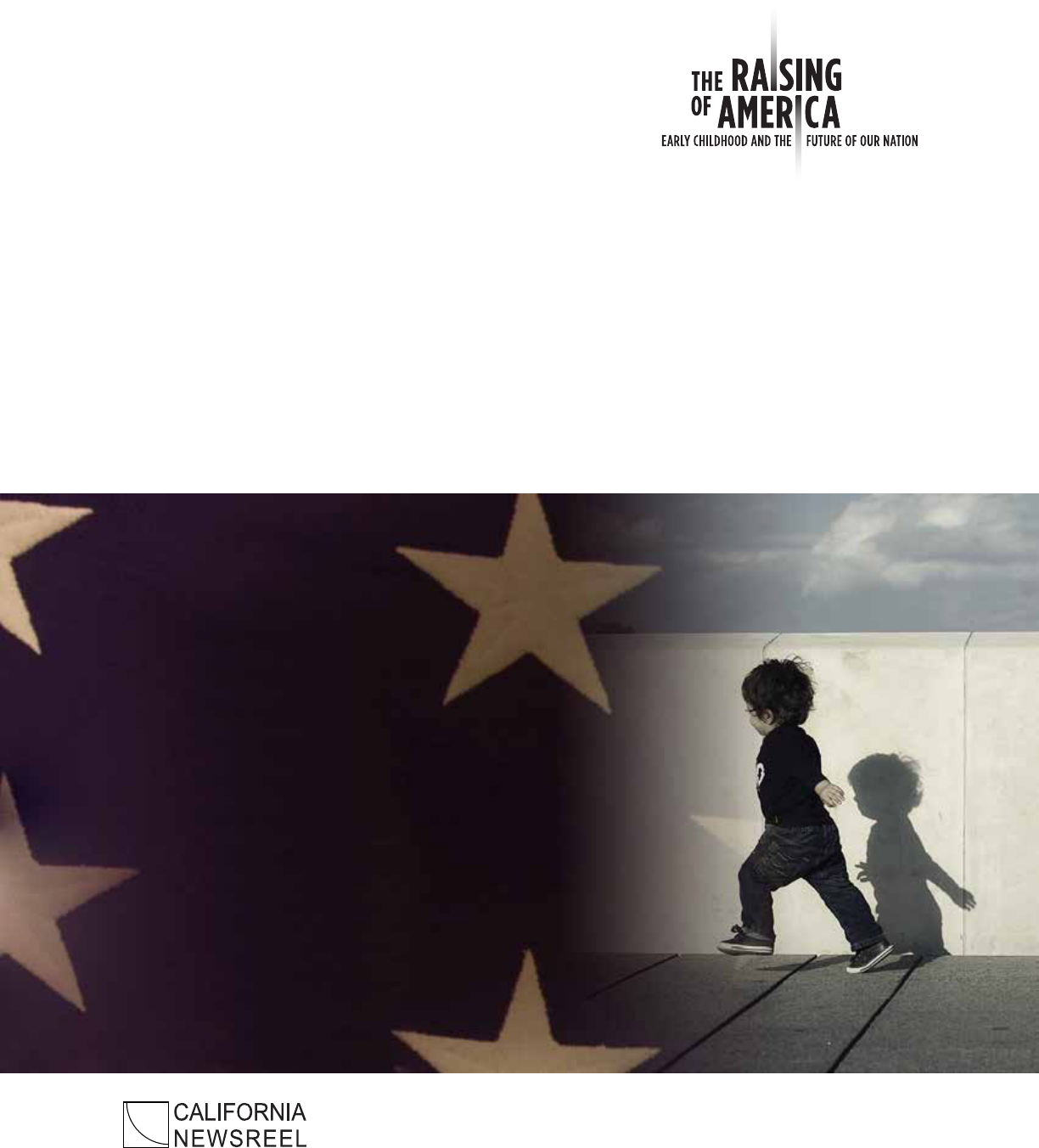
EPISODE 2:
ONCE UPON A TIME
Discussion Guide
WHEN CHILDCARE FOR ALL WASN’T JUST A FAIRYTALE
raisingofamerica.org
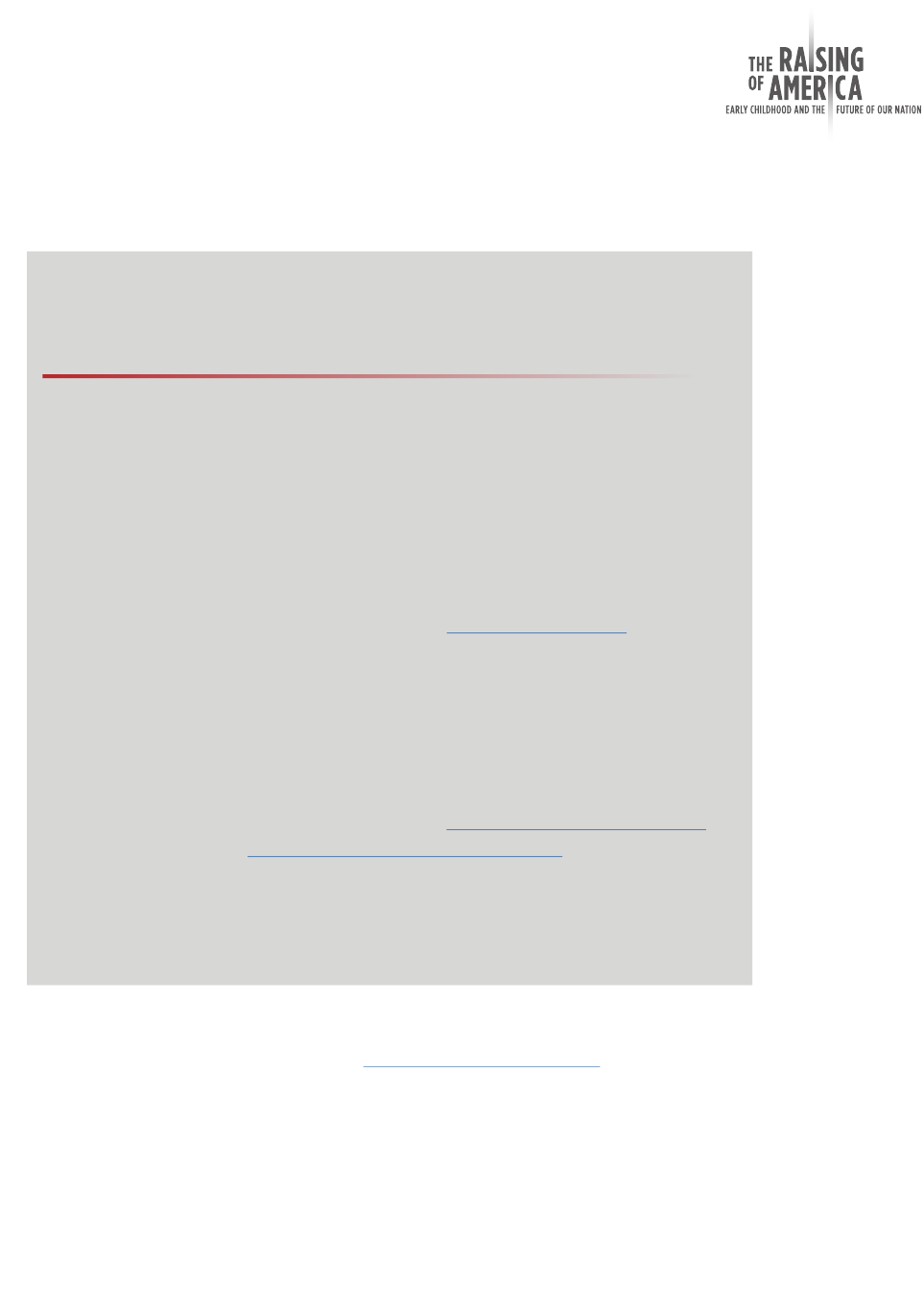
The Raising of America:
Early Childhood and the Future of Our Nation
e Raising of America is an ambitious documentary series and public
engagement campaign that seeks to reframe the way we look at early child
health and development. It illustrates how a strong start for all our kids leads not
only to better individual life course outcomes (learning, earning and physical and
mental health) but also to a healthier, safer, better educated, more prosperous
and equitable nation.
Learn more about each episode in the series at raisingofamerica.org:
• Ep 1: e Raising of America
• Ep 2: Once Upon a Time
• Ep 3: Are We Crazy About Our Kids?
• Ep 4: Wounded Places
• Ep 5: DNA is Not Destiny
View our hundreds of partner organizations at raisingofamerica.org/partners
and join the campaign (raisingofamerica.org/join-campaign) to change the
conversation about what we can—and should—do to give all our kids a strong
start.
is guide was developed by Faith Rogow, PhD, Insighters Education Consulting with input from
Larry Adelman and Rachel Poulain at California Newsreel. Shannon K’doah Range and Alisha Saville
produced the design.
Content from this guide may be reproduced without permission provided the following credit is
included: “Taken from THE RAISING OF AMERICA Discussion Guide. Copyright © 2015
California Newsreel.”
Copyright © 2015 California Newsreel
EPISODE 2:
ONCE UPON A TIME
Discussion Guide 1.0

In This Guide
A) ABOUT THE FILM
Synopsis ..................................................................................................... 1
emes & Film Chapters .......................................................................... 3
Film Participants ....................................................................................... 4
B) DISCUSSING THE FILM
1. Facilitating the Discussion ..................................................................... 5
2. Pre-Viewing Activity ................................................................................ 6
3. Post-Viewing Discussions ...................................................................... 8
a) Opening Prompts ..................................................................... 8
b) Comprehension Check-ins ....................................................... 9
c) Personal vs. Collective Responsibility ....................................... 10
d) Economics ................................................................................ 13
e) Politics ...................................................................................... 15
f ) Family Values ............................................................................ 20
g) Summing Up ............................................................................ 23
4. Moving to Action .................................................................................. 24
C) BACKGROUND & RESOURCES
e Comprehensive Child Development Act of 1971 (S-1512) ............... 26
What Does “Quality” Mean? ..................................................................... 27
Statistics Related to the Film .................................................................... 29
Resources on Childcare in the U.S. ............................................................ 31

1
ABOUT
THE FILM
A
DISCUSSION GUIDE: Once Upon a Time © 2015 California Newsreel
www.raisingofamerica.org
TABLE OF
CONTENTS
Once Upon a Time
SYNOPSIS
Episode 2: Once Upon a Time (32 minutes) is part of the documentary series
e Raising of America: Early Childhood and the Future of Our Nation.
is episode asks:
How did a country that says it cares
about its youngest children and
families end up with a system that
neglects the needs of so many of them?
Once Upon a Time helps viewers understand why the United States never
adopted early childhood initiatives such as universal childcare, programs
which are taken for granted in most other rich nations. In 1971, Congress
passed the Comprehensive Child Development Act (CCDA) with a
bipartisan majority. e bill guaranteed to any parent who wanted it, high-
quality childcare and early education from birth to age ve, universal medical
care, home visiting and other support services for families with young
children. e episode reveals why the CCDA never became law, despite its
popular support.
e CCDA grew out of the Civil Rights movement and President Lyndon
Johnson’s War on Poverty and was part of his Great Society vision to spread
opportunity to those historically excluded. Sponsors of the legislation had
reason to be optimistic. eir position was backed by solid evidence that
quality early care would help children and their parents and even pay for
itself. e initiative enjoyed broad bipartisan support. And the country’s
successful creation of a network of childcare centers during World War II
(for children whose mothers’ labor was needed in American factories) had
already proven that we were capable.

2
ABOUT
THE FILM
A
DISCUSSION GUIDE: Once Upon a Time © 2015 California Newsreel
www.raisingofamerica.org
TABLE OF
CONTENTS
President Nixon’s 1968 presidential campaign included promises to improve
the lives of all of America’s youngest children, so backers were stunned by his
11th hour veto of the CCDA. Once Upon a Time reveals how an elite group
of conservatives viewed the defeat of the CCDA as a watershed possibility
and brought pressure on President Nixon to veto the bill.
For conservatives, the veto marked an initial victory in what would
become a radical shift away from using government as a tool to enable
more Americans to share in the prosperity of our economy. Relying on
wordsmithing by young White House speechwriter Patrick Buchanan,
President Nixon’s veto message rejected the CCDA not just because
of its cost but on ideological grounds as government intrusion on the
family—a government takeover of child rearing akin to so-called Soviet-
style “communal child-rearing.” ey also argued that parents who make
the “right choices” by being responsible and working hard do not need
help from the government anyway, so the CCDA was unnecessary. Nixon’s
veto was the rst time ‘family values’ were invoked to undermine family
friendly legislation. e veto also marked a critical inection point from
our movement towards a more inclusive nation to the “you’re-on-your own”
society that characterizes much social policy today.
is “you’re-on-your-own” vision of society—and its de-legitimation of
government action on behalf of all citizens—continues to resonate in
current political, budget, and policy debates. Yet in 1971 we came achingly
close to providing quality early care and preschool and other services for
all American young children. By helping viewers understand the roots of
the tensions between those who embrace a vision of a “we’re in it together”
society and those who believe that children’s chances should be shaped
primarily by the resources of individual families, Once Upon a Time allows
viewers to learn how we got here while communicating a sense of possibility
and hope for the future.

3
ABOUT
THE FILM
A
DISCUSSION GUIDE: Once Upon a Time © 2015 California Newsreel
www.raisingofamerica.org
TABLE OF
CONTENTS
1960s
American individualism
Childcare, preschool and early education
Child development
Civil rights
Collective responsibility
Conservative politics
Early childhood policy
Family-work life balance
Government
Great Society programs
Head Start
Political science
President Richard Nixon
Rosie the Riveter
Social movements
Social services
U.S. 20
th
century history
U.S. political history
Walter Mondale
Women’s movement
War on Poverty
THEMES
Once Upon a Time is appropriate for audiences interested in:
FILM CHAPTERS
1. 00:00 – Prologue: The State of U.S. Childcare
2. 04:09 – Once Upon a Time: The Lanham Act
3. 06:13 – Towards a More Inclusive America
4. 09:05 – The Birth of Universal Childcare
5. 13:49 – A Bill Whose Time Has Come?
6. 16:15 – Roots of the Opposion
7. 18:32 - What the Legislaon Covered
8. 20:20 - The Opposion Plots Power
9. 24:39 - America Changes Course
10. 29:10 - The Military Gets Smart

4
ABOUT
THE FILM
A
DISCUSSION GUIDE: Once Upon a Time © 2015 California Newsreel
www.raisingofamerica.org
TABLE OF
CONTENTS
FILM PARTICIPANTS
In order of appearance
Maria Langley
Director, Browne Child Development Center,
Camp Pendleton Marine Corps Base
Clare Sanford
Early Childhood Education Enrollment &
Nutrition Manager, YWCA of Minneapolis
Children’s Centers
Laura Lovett
Associate Professor, Department of History,
University of Massachusetts, Amherst
Founding Editor, Journal of the History of
Children and Youth
Marian Wright Edelman
President, Children’s Defense Fund
Robert Self
Professor of History, Brown University
Author, All in the Family
Sid Johnson
Legislative Aide to Senator Mondale
1969-1976
Walter Mondale
Senator from Minnesota (D)
U.S. Vice President to President Carter,
1977-1981
Edward Zigler
Director, Oce of Child Development
Chief, U.S. Children’s Bureau, 1970-1972
Phyllis Schlay
Founder & President, Eagle Forum
Patrick Buchanan
White House Advisor, Nixon Administration
1969-1974
Brigadier General Vincent Coglianese
Camp Pendleton Marine Corps Base
ALSO REFERENCED
John Brademas
Congressman from Indiana (D), 1959-1981
Richard Nixon
U.S. President, 1969-1974

5
DISCUSSING
THE FILM
B
DISCUSSION GUIDE: Once Upon a Time © 2015 California Newsreel
www.raisingofamerica.org
TABLE OF
CONTENTS
1. Facilitating the Discussion
A successful lm screening allows participants to:
• Watch purposefully and critically
• Reect on what they’ve seen
• Consider new information and how it arms/conicts with
preconceived ideas
• Bring viewers’ attention back to their own situation and how
they might tackle inequities
• Learn from others in the room
Your job as facilitator is not to lecture but to encourage participation and
keep the discussion focused and owing. Be prepared to accept reactions to
the lm without judgment. If people feel that you are shing for particular
opinions, they are less likely to engage.
At the same time, participants will look to you to keep the discussion from
wandering. If necessary, gently guide discussants to consider how their
personal experiences or concerns reect larger systems, structures and
policies.
Prior to the discussion, be sure to preview the lm yourself so you won’t be
processing your own reactions to the issues while trying to guide the group.
You can also preview the transcript of the episode at
www.raisingofamerica.org/once-upon-time.
Finally, plan in advance how you will deal with logistical issues, including
strategies to ensure that everyone who wishes to speak has an opportunity to
be heard.

6
DISCUSSING
THE FILM
B
DISCUSSION GUIDE: Once Upon a Time © 2015 California Newsreel
www.raisingofamerica.org
TABLE OF
CONTENTS
2. Pre-Viewing Activity
Before you show the lm to your audience, you can get them thinking about
the issues involved. You can use the “Agree or Disagree?” activity on the
following page to start a pre-viewing conversation and get your audience
engaged.
ere are several options for soliciting responses to this activity:
• Distribute a handout and invite people to write down answers
• Create an agree/disagree line on the oor and ask people to
physically move to the spot on the line that indicates their view
as you read aloud one or more of the statements
• Read aloud one or more of the statements and give people a
moment to think about what their response is
If time allows, you might invite people to pair-and-share selected responses
and reasoning for their positions, or discuss in small groups.
(cont. ⇢ )

7
DISCUSSING
THE FILM
B
DISCUSSION GUIDE: Once Upon a Time © 2015 California Newsreel
www.raisingofamerica.org
TABLE OF
CONTENTS
AGREE OR DISAGREE?
On a scale of 1-10, do you agree or disagree with these statements?
(1 =”don’t agree at all, not even a little bit”; 10 =“wholeheartedly agree”)
• People who can’t aord to raise children shouldn’t have
them.
• Anyone in the U.S. who works hard and makes
responsible choices can improve their economic status
without government help.
• Government assistance to families produces greater
payos than government programs or policies designed
to create a favorable investment climate for Wall Street.
• It’s easier today for most young families to provide for
their babies’ and children’s well-being than it was 60 or
70 years ago.
• Some income inequality is desirable, but when the gap
grows too large, it threatens American democracy.
• Children are our future, so government has a
responsibility to invest in their well-being.
• Social programs designed to combat poverty are more
likely to instill a sense of dependence on government
than to help people improve their economic situation.
• e Constitution’s guarantee of “life, liberty, and the
pursuit of happiness” means that individual families
should be able to raise their children without any
government interference.
• Pre-K should be universally available at no charge to all
children, just as K-12 is now.
• Mothers (or fathers) should stay home and take care of
their young children until they enter kindergarten.
As you view the lm, try to determine how the lmmaker would respond
to these statements and make note of the evidence that backs up the lm’s
conclusions.

8
DISCUSSING
THE FILM
B
DISCUSSION GUIDE: Once Upon a Time © 2015 California Newsreel
www.raisingofamerica.org
TABLE OF
CONTENTS
3. Post-Viewing Discussions
e questions and prompts in this section are designed to help a wide range
of audiences understand, analyze, explore and reect on what they’ve seen, as
well as on what they hear from others in the room. ere is no need to use
all the questions or use them in any particular order. Choose those that best
meet the needs of your group.
A) OPENING PROMPTS
1. If a friend asked you what this lm was about, what would
you say?
2. Name three things from the lm: one that surprised you, one
that frustrated you, and one that inspired you. How did the
things you named compare to the things named by others in
the room? How would you account for the similarities and
dierences?
3. Jot down a “tweet” describing the lm’s most important
messages.
Ð After people have had a minute or two to compose their
tweet, invite volunteers to share what they wrote (and,
if they wish, to send the tweet). Discuss whether there
is a consensus about what the main message is or why
people may have had dierent ideas about the main
message.

9
DISCUSSING
THE FILM
B
DISCUSSION GUIDE: Once Upon a Time © 2015 California Newsreel
www.raisingofamerica.org
TABLE OF
CONTENTS
B) COMPREHENSION CHECK-INS
1. What was the Comprehensive Child
Development Act (also known as the
Mondale-Brademas bill)? Why didn’t it
become law?
2. What was the Lanham Act (WWII) and
what were the circumstances that led to
its passage—and to the dismantling of its
programs?
3. What was President Lyndon Johnson’s Great Society vision
and why did he and others believe that the programs passed by
Congress were an eective way to combat poverty?
4. What factors led to an increase in women’s workforce
participation in the 1970s and forward?
5. What is the dierence between “custodial care” and “quality
care”?
6. Why did President Nixon veto a bill which had broad popular
support, including members of his own administration?

10
DISCUSSING
THE FILM
B
DISCUSSION GUIDE: Once Upon a Time © 2015 California Newsreel
www.raisingofamerica.org
TABLE OF
CONTENTS
C) PERSONAL VS. COLLECTIVE RESPONSIBILITY
1. Clare Sanford identies the essence of the
conicts over government support for child
development services saying, “We want
to believe that every individual is able to
pull themselves up with their own boot
straps and there’s a sense that providing
for children and families in some ways is a
form of government interference instead of
support for families and children.”
• Do you agree with the belief that everyone is “able to pull
themselves up with their own bootstraps?” Why or why not?
• How does this attitude relate to the belief that the United
States is a meritocracy?
• What are the origins of the attitude that government action
is interference in the family?
• Do you agree with this belief about government? Why or
why not?
• Who benets most from the notion that government
programs for children and families are “interference”? What
other sectors of society have used that argument to their
benet?
• How can populations and institutions benet from
aordable high-quality childcare and early education for all?
(cont. ⇢ )
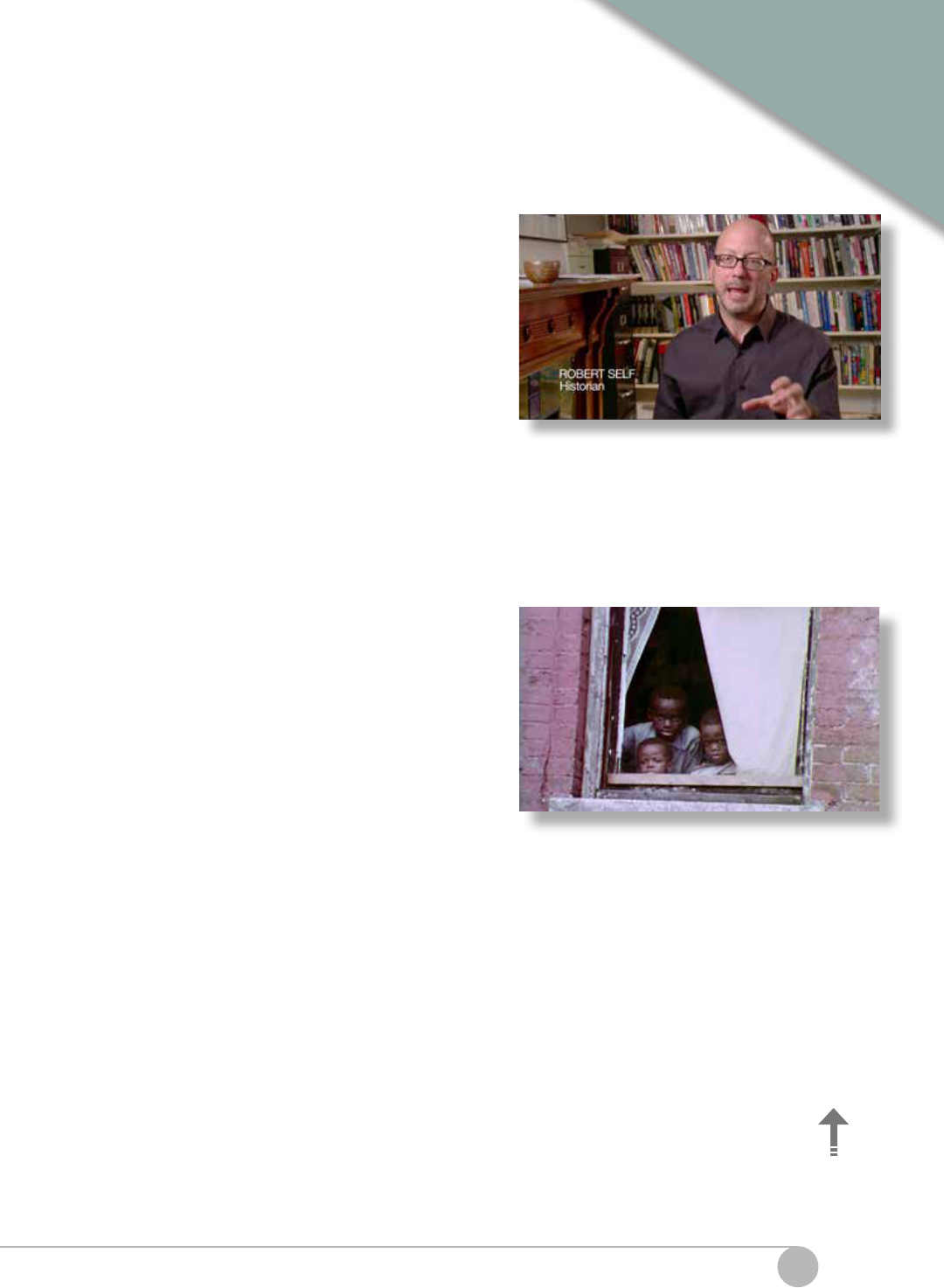
11
DISCUSSING
THE FILM
B
DISCUSSION GUIDE: Once Upon a Time © 2015 California Newsreel
www.raisingofamerica.org
TABLE OF
CONTENTS
C) PERSONAL VS. COLLECTIVE RESPONSIBILITY (CONT.)
2. Historian Robert Self describes the Great
Society programs of the 1960s growing out
of a sense of “collective responsibility for
the health and well-being of all families.”
• Where do you see evidence of that
sense of “collective responsibility”
today?
• Why, in some circles, is the notion that
we are responsible for one another seemingly out of fashion
or even criticized as “wealth redistribution”?
• What’s changed since the 1960s that inuences our sense of
our relationship to other Americans?
3. Describing the inspiration for introducing
the CCDA, then-Senator Walter
Mondale tells the story of a local boy who
was hit and killed by a truck while rushing
back to school after sharing half his lunch
with his younger brother because mom
had to work and there was no aordable
childcare available. He asks, “How could
this happen in the richest country in the
world?”
• What was his answer? What would your answer be?
• How is this situation repeating in today’s United States?
(cont. ⇢ )

12
DISCUSSING
THE FILM
B
DISCUSSION GUIDE: Once Upon a Time © 2015 California Newsreel
www.raisingofamerica.org
TABLE OF
CONTENTS
C) PERSONAL VS. COLLECTIVE RESPONSIBILITY (CONT.)
4. President of the Children’s Defense Fund,
Marian Wright Edelman, describes the
civil rights movement as being about
children. “Parents went and sacriced
everything in order to get their children a
better life and a fair chance to realize their
individual potential.”
• Why did racial minorities need
government support in the 1960s and
70s in order to give their children a
“fair chance”?
• Why wasn’t passage of the Civil Rights Act, by itself,
enough to equal the playing eld for children who weren’t
white?
5. Opponents of the CCDA and other government programs to
help the poor or working families often claim they will undercut
“personal responsibility.”
• What do you think?
• Why is the “personal responsibility” argument used against
benets that help low income people but not to benets
that help businesses and the wealthy, such as tax preferences,
home mortgage deductions for second homes, bank bailouts,
oshore tax havens, or even Social Security and Medicare?
6. ere is a huge range in the quality of child development
services oered by childcare centers.
• How would you dene quality?
• How would you know what to look for in evaluating the
quality of a childcare center or preschool for your child?
• In your view, what role should government play in setting or
regulating quality standards?

13
DISCUSSING
THE FILM
B
DISCUSSION GUIDE: Once Upon a Time © 2015 California Newsreel
www.raisingofamerica.org
TABLE OF
CONTENTS
D) ECONOMICS
1. Clare Sanford says that she spends more on childcare than for
her mortgage—18-19% of the family’s gross income for two
children in full-time care.
• As a percentage of your income, how much do you/did you
spend on childcare (or how much would you have to spend
if you had a child)?
• What do you think is a reasonable amount to spend?
2. According to the U.S. Bureau of Labor
Statistics, the median wage for childcare
sta in 2013 was $19,600 a year, lower
than poverty level income for a family of
three.
• What might the consequences
be if employers don’t pay those
whom we entrust with the care and
development of our children a wage
high enough for them to take care of
their own children?
• In terms of establishing fair pay for early childhood
professionals, what are the alternatives if average families
can’t aord to pay more for childcare than they currently
pay?
(cont. ⇢ )

14
DISCUSSING
THE FILM
B
DISCUSSION GUIDE: Once Upon a Time © 2015 California Newsreel
www.raisingofamerica.org
TABLE OF
CONTENTS
D) ECONOMICS (CONT.)
3. Between the end of World War II and the start of President
Johnson’s Great Society initiatives, the government provided
low-cost mortgages, farm and small business loans, college
tuition, job training, and tax deductions for dependent children.
Most of the programs were racially restricted, helping white
Americans but not others. But for white Americans, these federal
subsidies “facilitated a move on a grand scale into what we would
think of as middle class,” according to historian Laura Lovett.
• In what ways would providing aordable, accessible, high-
quality universal childcare facilitate people today moving
into or maintaining their status as part of the middle class?
4. After watching historical television news
footage announcing Pres. Nixon’s veto,
Clare Sanford says, “Can you imagine if
there was a federal program with sliding
fee childcare? Would that be fantastic?”
• Do you agree or disagree?
• How might the nation be dierent
today if high-quality universal
childcare had been available to all for
the past four decades?
5. ere have been a number of studies analyzing the costs and long
term benets of high-quality childcare and preschool programs.
• In what ways might these programs pay for themselves?
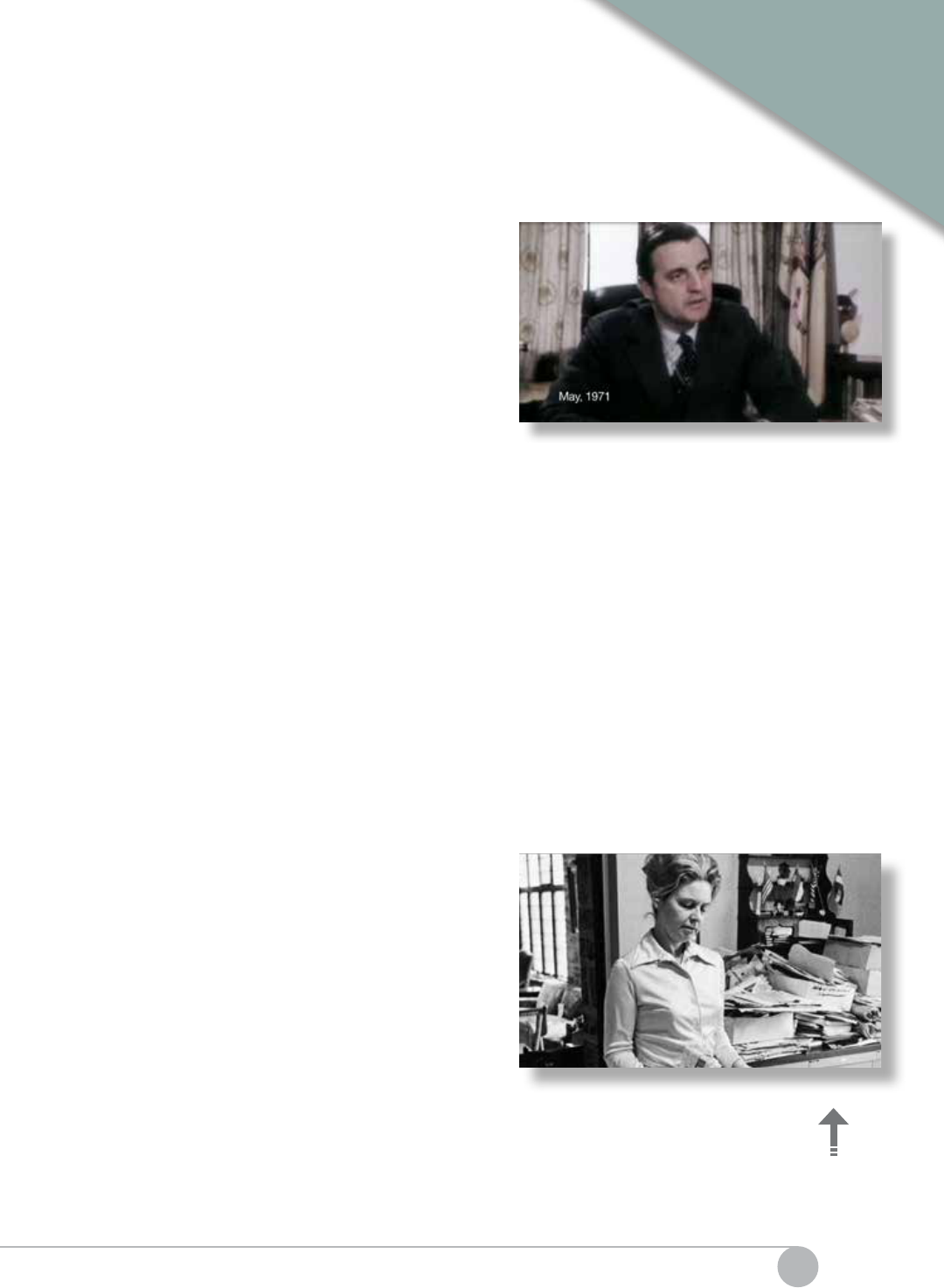
15
DISCUSSING
THE FILM
B
DISCUSSION GUIDE: Once Upon a Time © 2015 California Newsreel
www.raisingofamerica.org
TABLE OF
CONTENTS
E) POLITICS
1. With endorsements from e League
of Women Voters, the American Home
Economics Association, the Parent
Teacher Association, the National
Conference of Catholic Charities, the
American Academy of Pediatrics and a
legion of other, Mondale says, “ere was
an overwhelming consensus that this was
a sensible, reasonable bill. We were close
to getting something that would give
young Americans in that situation a better
chance.”
• What did you learn from the lm about the ways in which
power and politics can trump popular will and shape policy?
• Why didn’t supporters of the CCDA expect the opposition
that arose?
• How did the opposition succeed in the face of so much
support?
2. Why was the bill named the Comprehensive Child
Development Act and not, say, the Universal Childcare Act?
3. e CCDA was re-introduced in Congress
twice after its 1971 veto. In a 1976
newspaper editorial by Phyllis Schlay
entitled “Mondale and the Baby-Sitting
Bill,” the Conservative leader wrote, “We
are told that the Mondale-Brademas
bill will strengthen the family, whereas it
will actually do the opposite because it
will relieve parents of their responsibility
for child rearing. Anyone who wants to
strengthen the family should encourage
mothers to stay home and care for their
own preschool children.” (Observer-
Reporter, August 3, 1976, A-4)
(cont. ⇢ )

16
DISCUSSING
THE FILM
B
DISCUSSION GUIDE: Once Upon a Time © 2015 California Newsreel
www.raisingofamerica.org
TABLE OF
CONTENTS
E) POLITICS (CONT.)
• Was the use of the word “babysitting” in the title fair? Why
might Schlay have chosen that word?
• In your experience, does having childcare available “relieve
parents of their responsibility for child rearing”?
• If the only proper way to strengthen the family is for
mothers to stay home, what does that mean for women who
must work or want to in order to support their families?
4. Presidential aide Charles Colson told
President Nixon that he asked Patrick
Buchanan to get involved because “the
words we use are very, very important.” At
the time, what was the particular power of
words like “radical,” “Soviet,” and “family
values?”
• Why did these words carry weight?
• What trigger words are used in today’s debates over early
childhood policy and what gives them their power?
5. Walter Mondale explains the failure to
enact the CCDA saying that opponents
found “a golden vein of anxiety in
America.” His legislative aide added, “Fear
in politics almost always triumphs hope.”
• What, exactly, were people afraid of?
• Why did those fears outweigh the
fears of children not having an equal
chance to achieve the American
Dream?
• What fears exist today that impede providing universal early
childhood services to American families?
• What actions could you take to help people overcome those
fears?
(cont. ⇢ )

17
DISCUSSING
THE FILM
B
DISCUSSION GUIDE: Once Upon a Time © 2015 California Newsreel
www.raisingofamerica.org
TABLE OF
CONTENTS
E) POLITICS (CONT.)
6. Aside from the CCDA, can you identify other government
initiatives over the past century that were opposed with the
similar argument of: “We can’t aord it. It’s not government’s
job. It’s an intrusion on the family.”? What happened?
7. During WWII, when the nation needed women to work, there
was little opposition to the government providing childcare.
So if women need to work now, why do you suppose there isn’t
similar consensus about creating a system of aordable child
development centers?
8. e lm shows a Nixon campaign ad in
which the soon-to-be-President says, “I
ask you to help me make the American
dream come true, for those to whom it
seems an impossible dream today.”
• If he were making that request today,
what would the logical policy and
legislative outcomes be?
• How might the federal government
help make the American dream
come true “for those to whom it
seems impossible”?
(cont. ⇢ )
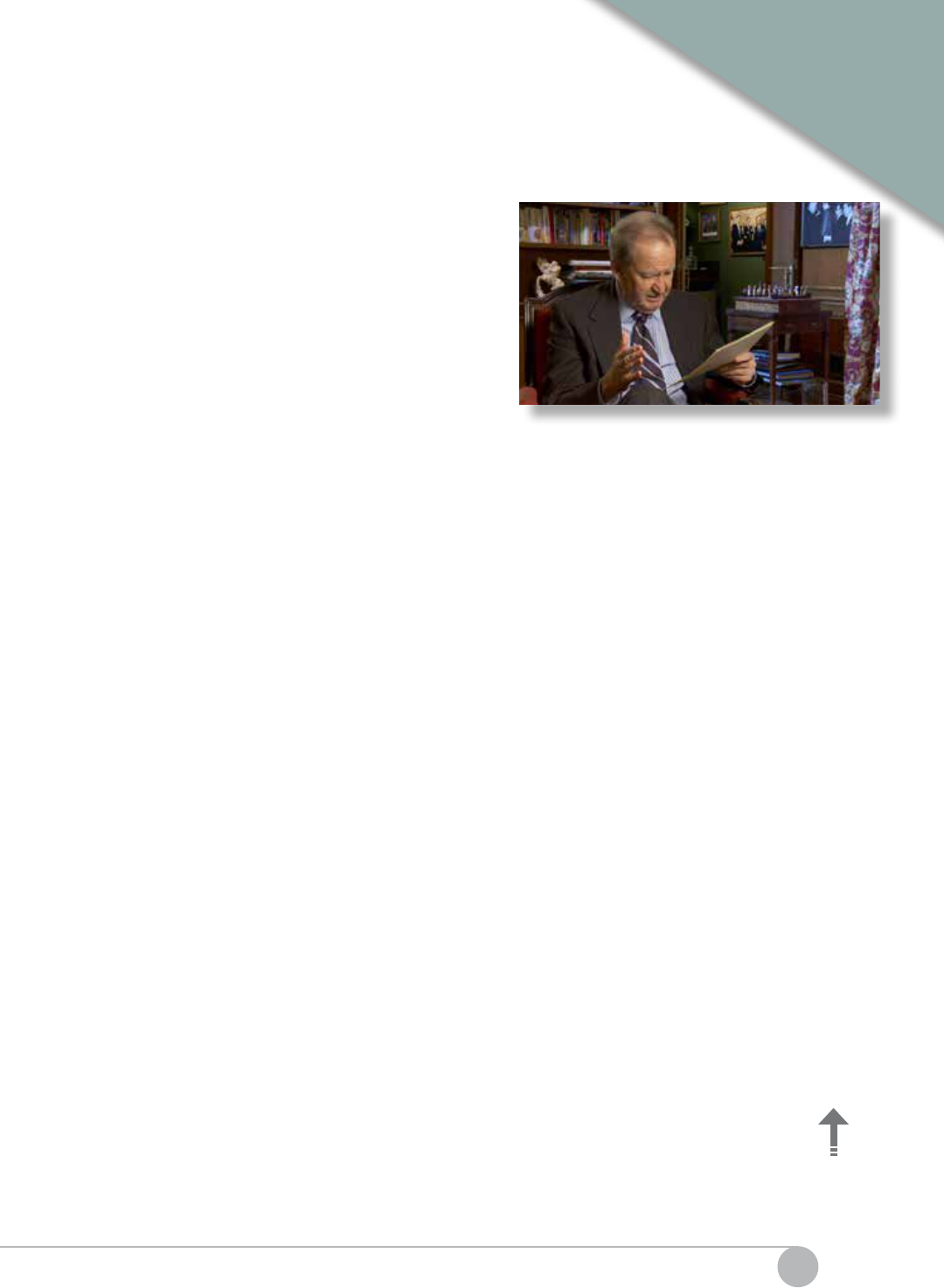
18
DISCUSSING
THE FILM
B
DISCUSSION GUIDE: Once Upon a Time © 2015 California Newsreel
www.raisingofamerica.org
TABLE OF
CONTENTS
E) POLITICS (CONT.)
9. Patrick Buchanan described the CCDA
as “the most radical piece of legislation
to come out of this Congress of the
United States.” He compared it to the
Soviet government “taking kids from
their parents and putting them into these
institutions and having them educated
there rather than at home,” which
didn’t seem to him “to be traditionally
American.” Do any of the features seem
“radical” or un-American to you? Review
each of the features and describe how
each would support or undermine families.
• $10 billion (in today’s dollars) would be appropriated in
the rst year to develop high-quality, universal childcare
and preschool, after-school care for older children, and
other services related to the health and well-being of young
children
• Children who needed them would be provided with meals,
medical treatment, and dental check-ups
• Home visiting programs for new mothers and counseling
would be made available to the poor for free and to everyone
else on a sliding scale
• Child development centers would be locally controlled
• Participation would be limited to children whose parents
requested services
10. e lm notes that the social programs responsible for the
growth of America’s middle class after World War II were
largely limited to whites.
• What role does race and racism play in support for or
opposition to government spending on child development
services?
• What about other social programs?
(cont. ⇢ )

19
DISCUSSING
THE FILM
B
DISCUSSION GUIDE: Once Upon a Time © 2015 California Newsreel
www.raisingofamerica.org
TABLE OF
CONTENTS
E) POLITICS (CONT.)
11. One of the programs for children established during the
Johnson Administration was Head Start, a preschool program
for children aged four and ve. Although Head Start, which
serves low-income families, has continued to receive funding,
there have never been enough slots available to meet the needs
of all eligible children. In 2013, for example, less than 50% of
eligible low-income preschoolers were enrolled in Head Start.
ough not all of those children would attend even if a slot was
available, many families who want services are being turned
away.
• Why do you suppose that this is the case?
• If Head Start is eective enough to receive continued
funding, why wouldn’t we choose to fund it at levels that
would guarantee a space to every eligible child?
12. In the 1990s, Congress passed Healthy Start, a program oering
pre-natal care, childcare, home visiting and other services to
low-income families for children from birth to age three. But
in 2013, its funding was so low it served less than 5% of eligible
children.
• Why do you think Congress never followed up the
authorization with the appropriation of sucient funding?
13. ere’s an argument about whether government subsidies for
childcare should be needs-based (like Head Start) or universal
(like Social Security).
• What do you think? Which is more likely to attract public
support and why?
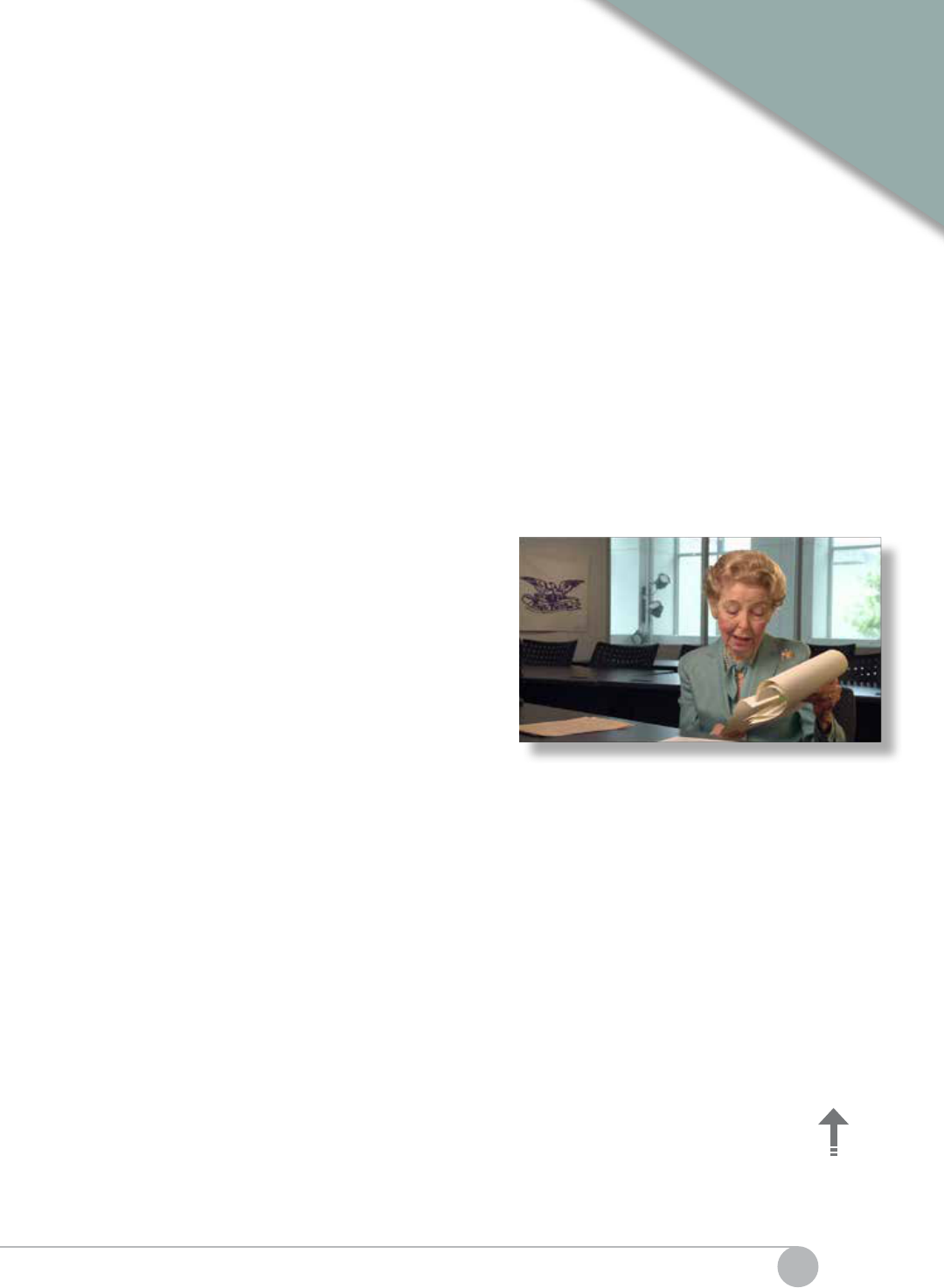
20
DISCUSSING
THE FILM
B
DISCUSSION GUIDE: Once Upon a Time © 2015 California Newsreel
www.raisingofamerica.org
TABLE OF
CONTENTS
F) FAMILY VALUES
1. e CCDA was going to be available to all those who wanted
it. Would you have been interested in having your children
participate? Why or why not?
2. Some Americans saw the Comprehensive Child Development
Act as increasing the strength of families while others believed it
would undermine American families.
• What evidence supported each of these positions?
• What were the weaknesses of each argument?
3. Buchanan and Schlay read from
Nixon’s veto statement: “For the
federal government to plunge headlong
nancially into supporting child
development would commit the
vast moral authority of the national
government to the side of communal
approaches to child rearing over and
against the family centered approach.”
• What’s your reaction to the way that
this frames the issue?
4. Historian Laura Lovett described a conservative narrative that
framed the ght for women’s rights and its “re-imagining of
gender roles as an attack on the family.”
• What did people like Phyllis Schlay nd threatening about
calls for women’s equality?
• Why did they interpret government attempts to help the
children of working women as a threat to the strength of
families?
(cont. ⇢ )

21
DISCUSSING
THE FILM
B
DISCUSSION GUIDE: Once Upon a Time © 2015 California Newsreel
www.raisingofamerica.org
TABLE OF
CONTENTS
F) FAMILY VALUES (CONT.)
5. Phyllis Schlay said that the CCDA was “really for the
government to take over the raising of children,” adding that
“that was not the kind of country we wanted to live in.”
• In today’s world, would you describe Head Start or other
childcare subsidy programs as a government takeover of
raising children? Why or why not?
6. Conservatives took the position that families who were
moral and worked hard would prosper without any help from
government. e implication is that families who needed or
received help were somehow immoral.
• Do you think that universal childcare would encourage
immorality? Why or why not?
• Studies show that a majority of auent and college
educated parents enroll their children in preschool programs.
Why is the “morality” argument not applied to them?
7. In order to save money, some people suggested that the
government fund only custodial rather than comprehensive,
high-quality care. Head Start’s rst Director, Edward Zigler,
rejected that approach because “just custodial care—a child
stacked with other children with no help—could be harmful.”
• Why might custodial care actually be harmful?
(cont. ⇢ )

22
DISCUSSING
THE FILM
B
DISCUSSION GUIDE: Once Upon a Time © 2015 California Newsreel
www.raisingofamerica.org
TABLE OF
CONTENTS
F) FAMILY VALUES (CONT.)
8. What lessons do you take away from the
aordable childcare oered by the Armed
Forces?
• How does that care enable soldiers to
do their jobs better?
• How does it help the country?
• Would any of the benets you listed
also apply to workers who aren’t in the
military?
• How does the military’s childcare
system challenge the claims of
Conservatives that universal childcare
is unnecessary or would weaken families?
9. Many parents rely on “friends and family” or other home-
based care arrangements for childcare rather than center-based
care. How might a government program improve rather than
undermine the friends and family care network?
10. Recent studies have revealed that preschool is the most racially
segregated of any level of American education. Why do you
think this is, and how might it be addressed?

23
DISCUSSING
THE FILM
B
DISCUSSION GUIDE: Once Upon a Time © 2015 California Newsreel
www.raisingofamerica.org
TABLE OF
CONTENTS
G) SUMMING UP
1. Describe one thing you learned from the lm. How does your
new insight aect the way you think about early care and
education?
2. What major questions was the lmmaker trying to answer (and
how do you know)?
• How did the lmmaker answer those questions?
• Did you agree with the answers? Why or why not?
• Were there other questions you wanted to ask, and if so,
what were they?
3. In what ways is this lm similar to or dierent from other media
you have seen, read, or heard on this issue? In what ways did it
conrm or challenge ideas you held?
4. If you could guarantee that policy makers and politicians would
watch this lm, what would you want their “takeaway” to be?

24
DISCUSSING
THE FILM
B
DISCUSSION GUIDE: Once Upon a Time © 2015 California Newsreel
www.raisingofamerica.org
TABLE OF
CONTENTS
4. Moving to Action
Ending discussions by planning action steps creates energy and optimism,
even when the conversation has been dicult. Powerful action ideas are
most likely to come from participants themselves, so we recommend leaving
time at the end of your event, meeting or class to brainstorm.
SUGGESTIONS FOR GETTING STARTED
1. Host a special screening of Once Upon a Time for the many
organizations in your area who would have an interest in the
issues it raises: childcare center sta and parents, of course, but
also neighborhood associations and other community-based
groups, aordable housing and racial justice advocates, service
clubs, PTAs, school volunteers, social service providers, your
local chapter of the American Academy of Pediatrics, and even
stakeholders such as law enforcement and juvenile justice.
• Remember to include government ocials and your local
Chamber of Commerce or other business groups. Invite
them to suggest ideas about how the business community
could help address the need for aordable, universal, high-
quality childcare in your city or town.
2. ere are a growing number of initiatives on the city, state and
federal level related to early childhood education. Find out
what’s happening in your city or state. Arrange to meet with
your elected representatives and their designated education
staers and explain what you think is important and why. Share
with them a copy of the lm along with key talking points.
3. In lieu of federal action, two states currently oer universal
preschool: Oklahoma and Georgia, both ‘red’ states. Research
and analyze those initiatives, how they are structured, why they
were passed into law, and what lessons—positive and negative—
you might take away from them.
(cont. ⇢ )

25
DISCUSSING
THE FILM
B
DISCUSSION GUIDE: Once Upon a Time © 2015 California Newsreel
www.raisingofamerica.org
TABLE OF
CONTENTS
4. Child Care Aware® of America (www.usa.childcareaware.
org) issues an annual report grading states on the quality and
the costs of the childcare oered. How does your state stack up?
Find ways to publicize what you discover.
5. Many states and some cities now oer subsidies for childcare
and preschool for low-income children. Research those subsidies
in your area, compare them to the cost of care, and determine
whether they are adequate. Share your ndings with your
community and local/state policy makers.
6. Investigate existing advocacy initiatives both locally and
nationally. Get in touch with those that interest you and nd out
how you can help.
7. Recent economic research summarized in the companion
episode Are We Crazy About Our Kids? suggests that high-
quality early care and education pays for itself in the long term
many times over. Consider screening this episode as a follow-up
to Once Upon a Time.

26
BACKGROUND
& RESOURCES
C
DISCUSSION GUIDE: Once Upon a Time © 2015 California Newsreel
www.raisingofamerica.org
TABLE OF
CONTENTS
Background & Resources
THE COMPREHENSIVE CHILD DEVELOPMENT
ACT OF 1971 (S-1512)
e Act was commonly known as the Mondale-Brademas bill for its co-
authors, Senator Walter Mondale (then a Senator from Minnesota) and
Representative John Brademas (a member of the House of Representatives
from Indiana). e bill easily passed in the Senate with bipartisan support,
but it was intensely debated in the House of Representatives where it was
signicantly amended before passage (186 in favor to 183 opposed).
e preamble of the Act summarized its goal:
“It is the purpose of this Act to provide every child with a fair
and full opportunity to reach his full potential by establishing and
expanding comprehensive child development programs and services
designed to assure the sound and coordinated development of
these programs, to recognize and build upon the experience and
success gained through Head Start and similar eorts, to furnish
child development services for those children who need them most,
with special emphasis on preschool programs for economically
disadvantaged children, and for children of working mothers and
single parent families, to provide that decisions on the nature and
funding of such programs made at the community level with the
full involvement of parents and other individuals and organizations
in the community interested in child development, and to establish
the legislative framework for the future expansion of such programs
to universally available child development services.”
To track what has happened to childcare legislation in the interim, visit:
www.law.cornell.edu/topn/comprehensive_child_development_act
To read the original bill in the Congressional Record, visit:
http://mondale.law.umn.edu/pdf18/v.117_pt.8_p.9869-9881.pdf
Source: www.irp.wisc.edu/publications/dps/pdfs/dp36976.pdf

27
BACKGROUND
& RESOURCES
C
DISCUSSION GUIDE: Once Upon a Time © 2015 California Newsreel
www.raisingofamerica.org
TABLE OF
CONTENTS
WHAT DOES “QUALITY” MEAN?
In current policy debates, “high quality” early care and education is
sometimes misinterpreted to mean that preschool or childcare should focus
on a very narrow set of academic and cognitive skills.
When e Raising of America talks about “high quality,” it means the set of
practices that proved to be benecial in the High Scope Perry Preschool and
other classic studies, as well as the initial Head Start programs and research-
based “best practice” ndings in the decades since the 1960s.
ese include care that:
• Is safe and provides an environment that includes
developmentally appropriate and well-maintained indoor and
outdoor physical environments
• Is aordable and accessible for all children and families
• Uses a developmentally appropriate curriculum that includes
these learning areas: social, emotional, physical, language and
cognitive
• Uses developmentally appropriate instruction that is exible
while also ensuring that teachers intentionally plan a daily
schedule that maximizes children’s learning through eective
use of time and play materials, includes time for self-initiated
learning, free play, and creative expression, oers opportunities
for children to learn individually and in groups according to
their developmental needs and interests, balances sedentary and
physical activities, and includes both indoor and outdoor time
• Is run by knowledgeable and well-trained program sta and
educators, including educators with advanced degrees in child
development
• Respects the whole child, including providing comprehensive
services that support children’s health, nutrition, and social well-
being
(cont. ⇢ )

28
BACKGROUND
& RESOURCES
C
DISCUSSION GUIDE: Once Upon a Time © 2015 California Newsreel
www.raisingofamerica.org
TABLE OF
CONTENTS
• Creates an environment that respects and supports diversity and
the cultural backgrounds of children and their families
• Establishes and maintains collaborative relationships with each
child’s family in ways that are sensitive to family composition,
language and culture, and in ways that help family members
increase their level of education
• Treats sta as professionals, including oering regular
opportunities for professional development and career
advancement
• Promotes positive relationships among all children and adults
to encourage each child’s sense of individual worth, sense of
security and belonging as part of a community and to foster each
child’s ability to contribute as a responsible community member
• Establishes relationships with and uses the resources of the
children’s communities to support the achievement of program
goals
• Adjusts programs according to feedback from ongoing
systematic, formal and informal assessment
Sources: www.naeyc.org/policy/excellence
www.naeyc.org/files/naeyc/Position%20Statement%20EC%20Standards.pdf (2005)

29
BACKGROUND
& RESOURCES
C
DISCUSSION GUIDE: Once Upon a Time © 2015 California Newsreel
www.raisingofamerica.org
TABLE OF
CONTENTS
STATISTICS RELATED TO THE FILM
POVERTY
In 2013, there were 19.9 million children under age ve in the United States.
Source: http://factfinder2.census.gov/faces/tableservices/jsf/pages/productview.xhtml
In 2011, 25% of children ages 0-5 lived in poverty.
Source: http://www.childstats.gov/americaschildren/eco1a.asp
In 2011, African-American children had a 39% poverty rate, almost three
times that of white children, who have a rate of 14 %.
Source: http://datacenter.kidscount.org/files/2013KIDSCOUNTDataBook.pdf
e 2014 poverty cuto for a family of three was $19,790. e U.S. Bureau
of Labor Statistics reports that the 2013 median wage for childcare workers
was $9.38/hour, or $19,510/annually.
Sources: www.familiesusa.org/resources/tools-for-advocates/guides/federal-poverty-
guidelines.html and www.bls.gov/oes/current/oes399011.htm
CHILDCARE PARTICIPATION
According to U.S. Census data, in 2011 just under half (49%) of the children
with employed mothers were primarily cared for by a relative—their father,
grandparent, sibling, other relative, or mother— while she worked. Another
24% were in a center-based arrangement (day care, nursery school, preschool,
or Head Start). irteen percent were primarily cared for by a nonrelative
in a home-based environment, such as care from a family day care provider,
nanny, babysitter, or au pair.
Source: http://www.childstats.gov/americaschildren/famsoc3.asp
In 1965, one tenth of children aged three or four were in some kind of
formal preschool institution; by 1970 it was one fth.
Source: Kimberly Morgan, “A Child of the Sixties: e Great Society, the New Right, and the
Politics of Federal Child Care,” Journal of Policy History, 13 (2001), 222.
(cont. ⇢ )

30
BACKGROUND
& RESOURCES
C
DISCUSSION GUIDE: Once Upon a Time © 2015 California Newsreel
www.raisingofamerica.org
TABLE OF
CONTENTS
In 1965, Mississippi created the largest Head Start program in the nation. It
served 13,000 children and created 3,000 new jobs.
In 2013, funding for Head Start (ages four and ve) was so low that it
served less than 50% of the eligible population in its preschool programs,
and the quality of programs varied greatly from state to state.
In 2013, funding for Early Head Start—established in 1994 to serve
children birth to age three and their families—was so low that it served less
than 5% of the eligible population.
CHILDCARE COSTS
e U.S. Census Bureau’s Survey of Income and Program Participation
reports that, in 2010, on average, households living below the poverty line
spent 40% of their monthly income on childcare services. For people above
the poverty line, the average was 7%. In the lm, Clare Sanford reports that
Clare Sanford she spends 18-19% of the family’s gross income, which is
more than the cost of her mortgage.

31
BACKGROUND
& RESOURCES
C
DISCUSSION GUIDE: Once Upon a Time © 2015 California Newsreel
www.raisingofamerica.org
TABLE OF
CONTENTS
RESOURCES ON CHILDCARE IN THE U.S.
ORGANIZATIONS
Children’s Defense Fund - www.childrensdefense.org
e website of the child advocacy organization founded by Marian Wright
Edelman (featured in the lm) is rich with research, statistics, policy
statements, and suggestions for action.
ink Progress
http://thinkprogress.org/education/2013/11/27/3003061/head-start-
enrollment
A very good summary of U.S. childcare statistics, including useful
infographics.
Child Care Aware® of America - www.usa.childcareaware.org
is information hub conducts and publishes an annual state-by-state survey
of childcare costs, services, and related information.
National Institute for Early Education and Research - www.nieer.org
is Rutgers University site aggregates a substantial body of research that is
searchable by topic.
Zero to ree - www.zerotothree.org
is advocacy organization provides research-based policy recommendations
and initiatives. It is a great place to start for those interested in working on
legislation and public policy.
National Healthy Start Association - www.nationalhealthystart.org
is advocacy organization works for equitable services and interventions
to improve birth outcomes and family well-being. It provides leadership
training along with calls to action.
Association for Maternal and Child Health Programs - www.amchp.org
is organization focuses on providing resources to state public health
leaders working to improve the health of women, children and families.

32
BACKGROUND
& RESOURCES
C
DISCUSSION GUIDE: Once Upon a Time © 2015 California Newsreel
www.raisingofamerica.org
TABLE OF
CONTENTS
BOOKS
Cohen, Sally. Championing Child Care (2001)
Fousekis, Natalie. Demanding Child Care: Womens Activism and the Politics of
Welfare, 1940-1971 (2011)
Hewlett, Sylvia Ann and Cornel West. War Against Parents (1998)
Lovett, Laura. Conceiving the Future: Pronatalism, Reproduction, and the
Family in the United States, 1890-1938 (2007)
Self, Robert. All in e Family (2012)
Zigler, Edward, Katherine Marsland and Heather Lord. e Tragedy of Child
Care in America (2009)
ARTICLES
Cahan, Emily, “Past Caring, A History of U.S. Preschool Care and
Education for the Poor, 1820-1965” (c.1989 - paper copy only, in research
binder)
Cohen, Abby, “A Brief History of Federal Financing for Child Care in the
United States,” e Future of Children, Financing Child Care, Vol. 6 No. 2
(Summer/Fall 1996)
Cohen, Jonathan, “e Hell at is American Childcare,” New Republic (15
April 2013) www.newrepublic.com/article/112892/hell-american-day-care
Morgan, Kimberly, “A Child of the Sixties: e Great Society, the New
Right, and the Politics of Federal Child Care,” Journal of Policy History, Vol.
13 No. 2 (2001)
Roth, William, “e Politics of Daycare: e Comprehensive Child
Development Act of 1971,” (1976) (www.irp.wisc.edu/publications/dps/
pdfs/dp36976.pdf)
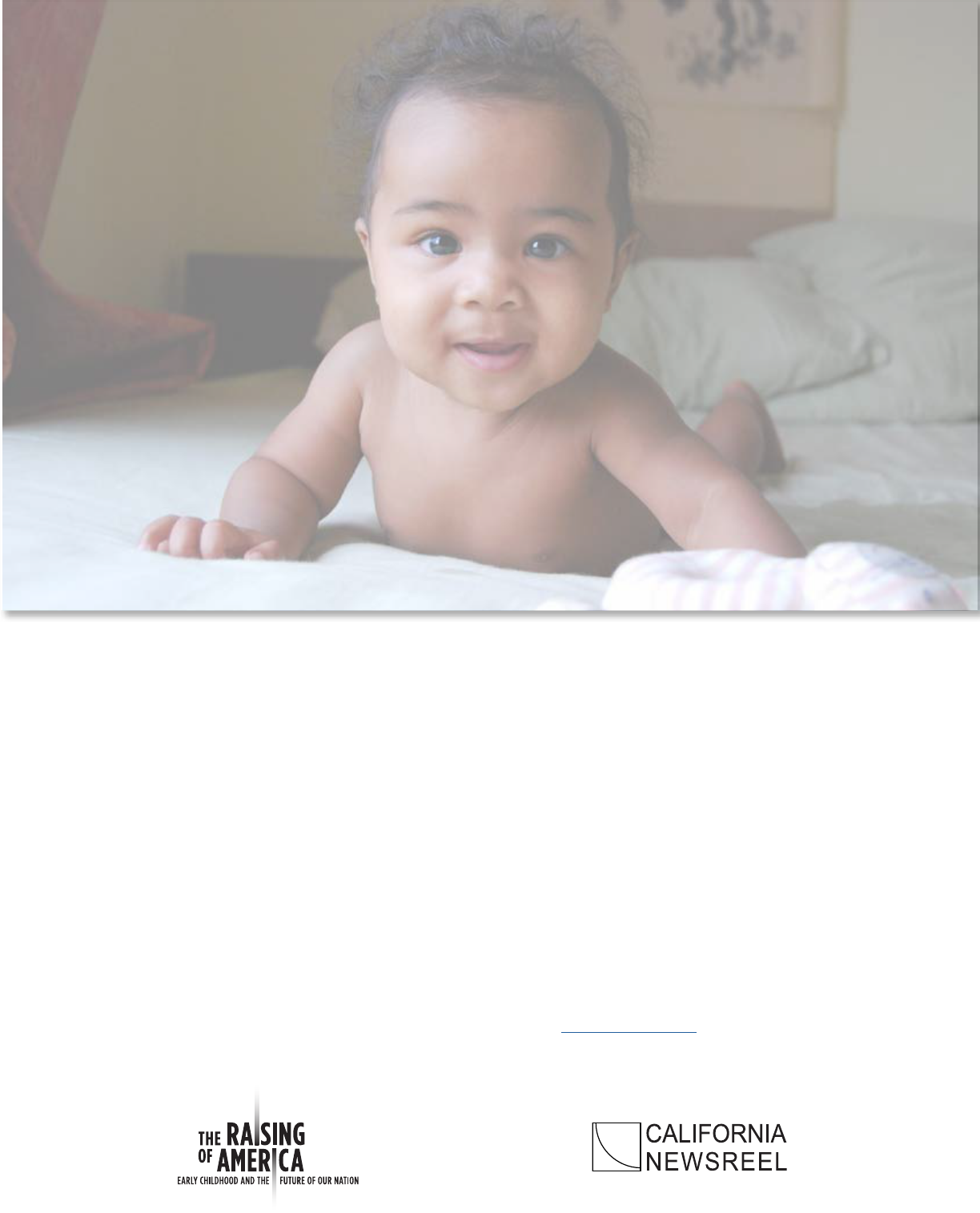
MAJOR FUNDING
e Raising of America project funded by:
• e W.K. Kellogg Foundation
• e California Endowment
• e United States Centers for Disease
Control and Prevention (CDC)*
Additional funding provided by:
• Kaiser Permanente
• e Blue Cross and Blue Shield of
Minnesota Foundation
• National Institute for Health Care
Management Foundation (NIHCM)
* is discussion guide was supported in part by Grant Number
CE002079 from the Centers for Disease Control and Prevention.
Its contents are solely the responsibility of the authors and do not
necessarily represent the ocial views of the Centers for Disease
Control and Prevention.
CALIFORNIA NEWSREEL
e Raising of America was produced by
California Newsreel with Vital Pictures.
California Newsreel produces and distributes
cutting-edge social justice lms that inspire,
educate and engage audiences. Founded in
1968, Newsreel is the oldest non-prot, social
issue documentary lm center in the country,
the rst to marry media production and
contemporary social movements.
Award-winning titles include Unnatural
Causes: Is Inequality Making Us Sick?, RACE-
e Power of an Illusion and Homegoings.
Visit www.newsreel.org to view over 150
documentary titles.
